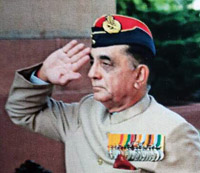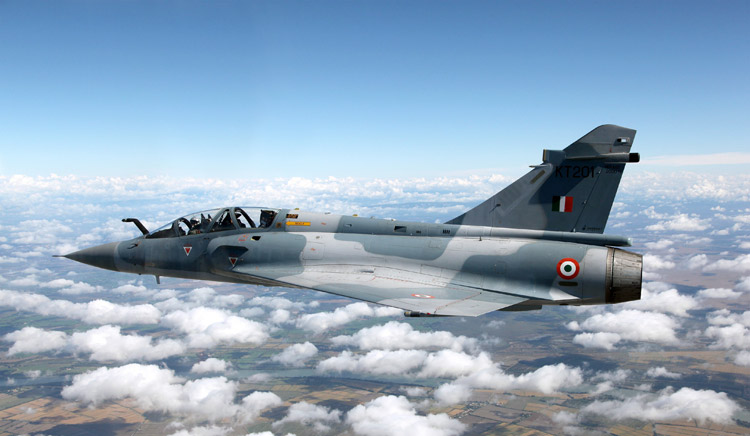INDIAN ARMED FORCES CHIEFS ON OUR RELENTLESS AND FOCUSED PUBLISHING EFFORTS

The insightful articles, inspiring narrations and analytical perspectives presented by the Editorial Team, establish an alluring connect with the reader. My compliments and best wishes to SP Guide Publications.

"Over the past 60 years, the growth of SP Guide Publications has mirrored the rising stature of Indian Navy. Its well-researched and informative magazines on Defence and Aerospace sector have served to shape an educated opinion of our military personnel, policy makers and the public alike. I wish SP's Publication team continued success, fair winds and following seas in all future endeavour!"

Since, its inception in 1964, SP Guide Publications has consistently demonstrated commitment to high-quality journalism in the aerospace and defence sectors, earning a well-deserved reputation as Asia's largest media house in this domain. I wish SP Guide Publications continued success in its pursuit of excellence.
Takeaways from Balakot
We need to move away from a hyped up national fervour bordering on jingoism orchestrated by a hyperbolic media to a balanced view on national security issues. A realistic assessment of our capabilities and limitations is imperative to adopt a mature approach.
 |
The Author is Former Chief of the Army Staff, Indian Army |

The Indian Air Force (IAF) needs to be complimented for a well planned, coordinated and meticulously executed strike on a crucial Jaish terror hub at Balakot, located in Khyber Pakhtoonwa province of Pakistan.
While going ahead with Balakot strike, the government simultaneously sent out signals to indicate that it did not want to escalate matters to a full-fledged confrontation with Pakistan. Addressing of the press conference, the Foreign Secretary (not the Defence Secretary) stressed on the 'preemptive' and 'non-military' nature of the strike intended to convey to the international community and the other side that India had acted against terror and not Pakistan and its military. However, this did seem to give credence to the allegations by a section of the public in both countries that it suited BJP's electoral politics.
The Pakistani response a day later by sending its air force in broad daylight to attack Indian military installations along the Line of Control (LoC) in Naushehra Sector was nothing more than a blunder knowing fully well that the IAF would be prepared for such a retaliation and would arrange a befitting reception. No wonder they lost a F-16 and a pilot in the process. Obviously, their response too reflected an effort to buttress public opinion that Pak military is no pushover.
Demolition of terror infrastructure which has wreaked havoc in the Kashmir valley for the last 30 years and bringing back peace and normalcy to the trouble torn area should always remain the focus of any administration.
Wing Commander Abhinandan's immediate release simultaneously with Pakistan Prime Minister Imran Khan's repeated requests to India to start a dialogue to resolve issues depicted Pakistan as a nation wanting peace and shifted the focus of the international community away from Pakistan's cultivation of terror infrastructure for proxy war in J&K. In the euphoria of Abhinandan's quick return, the shrill cacophony of perceived victory orchestrated by Indian electronic media changed the mood of the nation from anger to jubilation. A subsequent pronouncement by the government that a repeat of Pulwama would invite greater retribution for Pakistan next time effectively signaled closure of the Pulwama chapter and commencement of 'business as usual'.
Now that the dust seems to be settling down over our Balakot action and we are gradually getting back to 'normalization' with Pakistan, as happened post 26/11, Pathankot and Uri episodes, we need to look at the takeaways from the aftermath of the heinous Pulwama attack in which 40 of our brave CRPF jawans were martyred.
The Pulwama massacre, for which Jaish-e-Mohammed (JEM) has publically claimed responsibility, is part of the proxy war which Pakistan state has financially, diplomatically and militarily supported in J&K, to 'bleed India by a thousand cuts'. Their preferred weapon for achieving this is, of course, terrorism. We have lost more soldiers and civilians to this scourge than in all the wars fought since independence. It is not unusual to learn about 4 to 5 deaths daily in the Valley through the national print and electronic media. Unfortunately, the Indian conscience gets awakened only when large numbers get martyred like it happened at Uri and Pulwama!
This highlights the fact that an occasional one-off strike against terror infrastructure in Pakistan is not going to produce the desired results and a sustained and relentless targeting of terror modules both within and across the LoC needs to be undertaken.
Demolition of terror infrastructure which has wreaked havoc in the Kashmir valley for the last 30 years and bringing back peace and normalcy to the trouble torn area should always remain the focus of any administration. To achieve this, a synchronized and coordinated approach covering economic, diplomatic and military actions to continuously pressurize Pakistan both bilaterally and internationally need to be undertaken.
A surgical strike by the Indian Army in Sep 2016 post the Uri terror attack, which was claimed to be a game changer then, did not bring about any appreciable change in the pattern and intensity of terror attacks in the valley. In fact, the number attacks on the security forces including on those belonging to Kashmir increased in 2018, thus further deteriorating the situation. Currently, post the Balakot surgical air strike, there is hardly any decline in the terrorist activities. This highlights the fact that an occasional one-off strike against terror infrastructure in Pakistan is not going to produce the desired results and a sustained and relentless targeting of terror modules both within and across the LoC needs to be undertaken.
It has been variously claimed that Balakot strikes shifted redlines, enhanced politico military synergy, highlighted prowess of Indian military might, displayed our excellent intelligence acquisition capability, exposed Pakistan's nuclear ambiguity so on and so forth. From a professional perspective, it would be fair to say that some of these claims are yet to be fully proved for their effectiveness on ground. Let us examine them a little more in detail.
The red lines have indeed been shifted as a result of the Balakot strike. Proactive action taken by India in striking a target deep in Pakistan did change the perception that despite conventional superiority, India will not respond militarily to Pulwama incident because of possible threat of nuclear retaliation by Pakistan. However, if Balakot strike was meant to deter Pak from continuing its proxy war in J&K, it does not appear to have succeeded considering the undiminished intensity of encounters in the valley post Pulwama. The question that arises is that while a red line may have been breached, has it served our purpose of retaliation? Should repetitive action not be undertaken to achieve the desired result?
Enhancement of politico military synergy has indeed taken place. The need for simultaneous and synergized action at both national and international levels to expose Pakistan's nexus with terror and coordinated approach to tackle it politically as well as militarily is well acknowledged. However, such a methodology of functioning must be institutionalized in order to handle similar crisis in the future, at short notice. In fact, institutionalization may even prevent recurrence of such crisis as they may be foreseen in advance.
It may not be appropriate to conclude that the Balakot strikes highlighted the prowess of Indian military might as a very small portion of the military was employed by both sides. Only a full-fledged conflict can accurately bring out the prowess of a nation's military in relation to the adversary. In any case, we need to do a lot more in modernizing our military and improving its preparedness. An all party parliamentary committee led by Gen BC Khanduri concluded in March 2018 that 68% of the equipment held by the military is nearing obsolescence. The conventional superiority enjoyed by our military over Pak military in the past is gradually eroding. As a percentage of the GDP, our defence budget has been continuously declining over the last 10 years. The political authority should appreciate the fact that a nation can achieve greatness only when it is strong both economically and militarily. It may be interesting to note that China's military expenditure has been about three and half times more than ours for the last two decades.
Our intelligence acquisition capability against Pakistan can decisively be better than what it currently is. With massive satellite launching ability recognized the world over; we should be able to put in space satellites to monitor every single activity in Pakistan on a minute to minute basis. The human intelligence network dismantled during Prime Minister Narsimha Rao's time in the nineties has still not been resurrected fully. The irony is that even in J&K our intelligence failed to detect the occurrence of Pulwama strike by JEM in time, resulting in so many avoidable casualties!
As far as exposure of Pakistan's nuclear ambiguity is concerned, a onetime test cannot become the basis of such an assertion. It also needs to be appreciated that the decision to use its nuclear weapons rests solely with Pakistan. It may decide to use them when it feels its laid down threshold has been crossed in as far as its survival is concerned. This may not be related to Balakot type of air raid at all. In any case, only repeated forays in to Pakistan air space can provide a definitive conclusion whether its nuclear ambiguity stands exposed, if at all.
Protagonists of Balakot strike would not hesitate to come up with additional virtues of the strike to buttress their arguments. But that is where the basic argument shifts from pure professionalism to politicization, an aspect which needs to be avoided at all costs. National security must never be sacrificed at the altar of politics.
We need to move away from a hyped up national fervor bordering on jingoism orchestrated by a hyperbolic media to a balanced view on national security issues. A realistic assessment of our capabilities and limitations is imperative to adopt a mature approach. A professional military hierarchy is ideally suited to provide inputs for such informed decision making at the highest political levels. While bureaucrats have a useful role to play in rendering advice on governance issues, their limitations on professional military issues should not be lost sight of.





